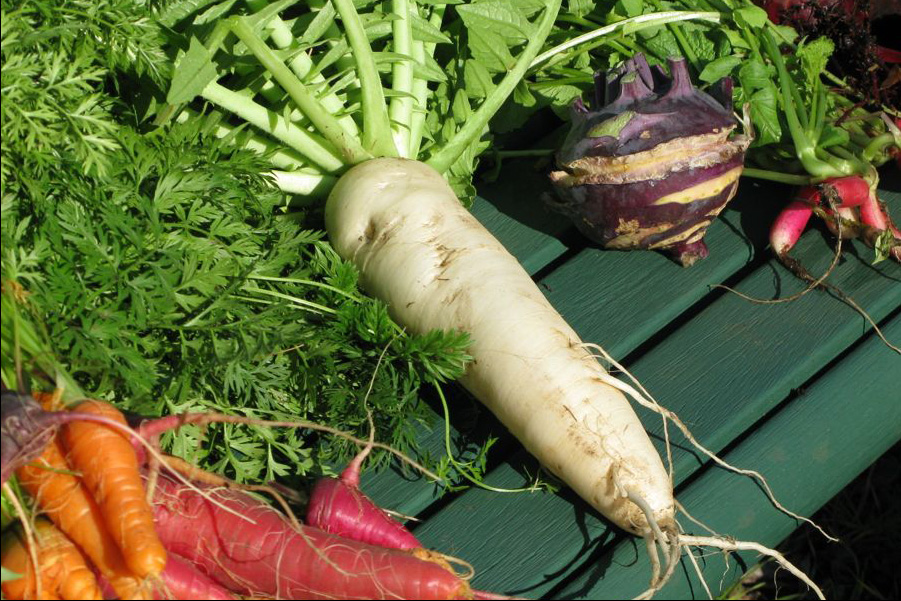Botanical name:
Raphanus sativus, var longipinnatus
Description:
Radishes are quick growing annual or biennial plants native to Asia, but can now be found worldwide. The daikon radish is grown for it’s swollen long tap roots, up to 40 cm long and 10 cm in diameter. The skin colour of the root is white, as is the flesh. The up to 60 cm long green leaves are arranged in a rosette on the centre of the root. The leaves show a big terminal lobe and several smaller lobes nearer to the root. If the radish goes to flower it shows the typical cross-shaped flower of the cabbage family with four petals. The daikon radish is a Winter variety of radish.
How to grow:
Sow 1.5 to 2 cm deep directly into well drained soil in spots 30 cm apart. Put in 3 seeds per spot, 2 cm apart. Choose a sunny place for Autumn and Winter and light-shade for Spring. Plants appear within a few days. Thin the plants to 2 and finally one plant per spot, 30 cm apart and mulch between the plants. Plants need to be watered consistently.
Doesn’t need much fertilising.
Harvest in about 10 weeks, as soon as the root has developed a good size, for sweeter flavour. Best flavour is when the root is about the size of a very big carrot.
Growing in the neighbourhood:
Likes to grow with pea, cucumber, nasturtium and lettuce.
Pests and other problems and how we deal with them:
Caterpillars of butterflies, especially the white cabbage butterfly are pests on daikon radish. We keep them out by netting the bed with a 5-10 mm net as long as the plants are small. A bit of leaf loss on mature plants is tolerable, if caterpillars take away too much leaf material we spray the plants with a bacterial solution that controls them.
All members of the cabbage family can be affected by a single-celled organism deforming the roots and making it hard for the plants to take up water. The problem is called club root and requires serious soil treatment. We try to avoid this by strictly rotating crops.
Season:
Autumn to early Spring
Seed-saving:
Radishes cross pollinate with other plants of the cabbage family. In order to collect useful seeds the mother-plant would need to be kept isolated.
How to harvest and use:
The whole plant is harvested. Radishes need to be harvested timely, so the flesh is crisp and sweet, it becomes bitter and tough if left in the ground too long. The bulb of the radish is kept to be eaten, the leaves are taken to the compost.
Every part of the daikon radish can be eaten. Daikon radish is usually eaten raw, sliced or grated, as part of a salad. It can also be steamed, simmered, stir fried, grated, pickled or baked. The raw flesh has a crisp texture and a mild peppery flavour.
